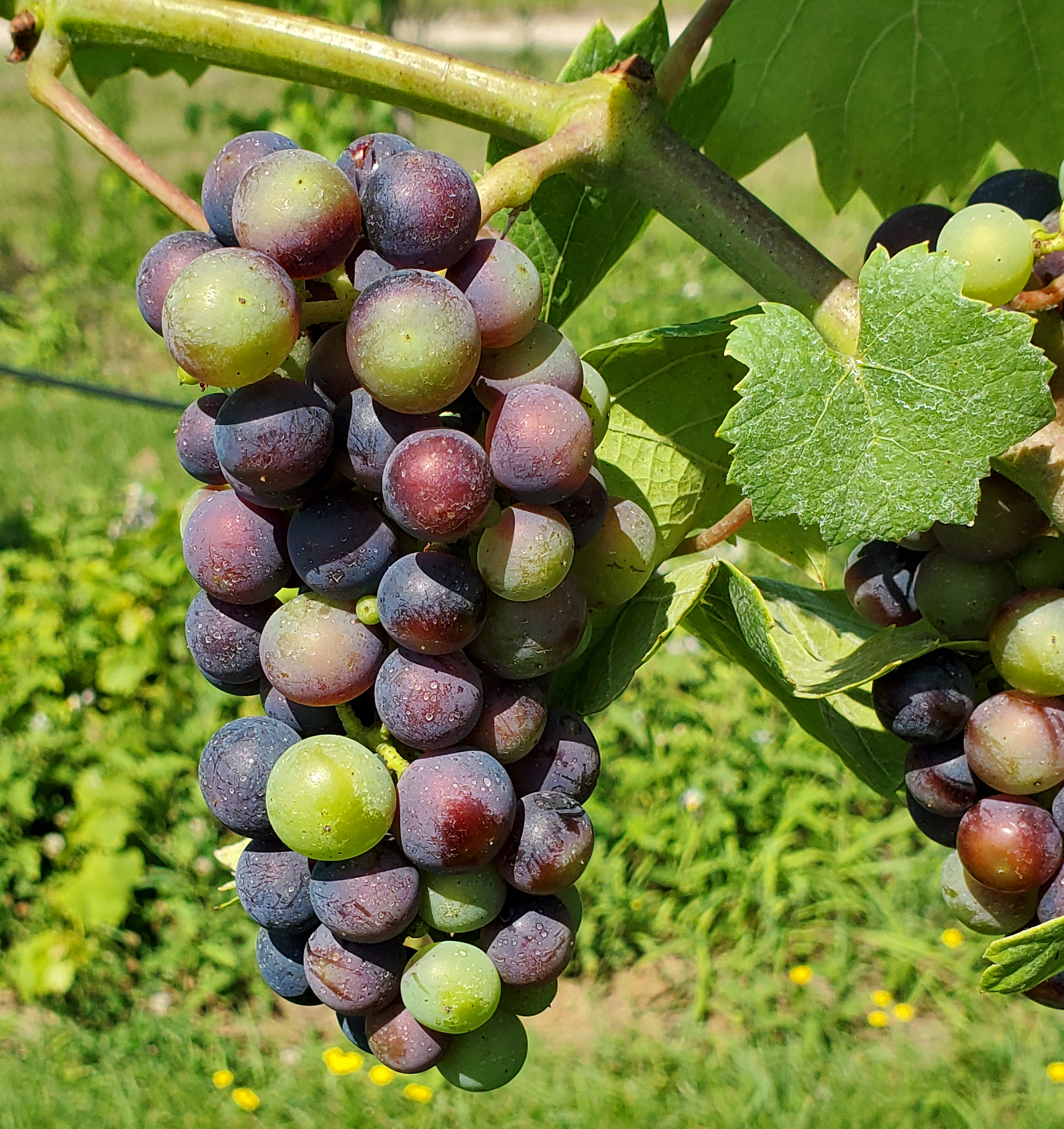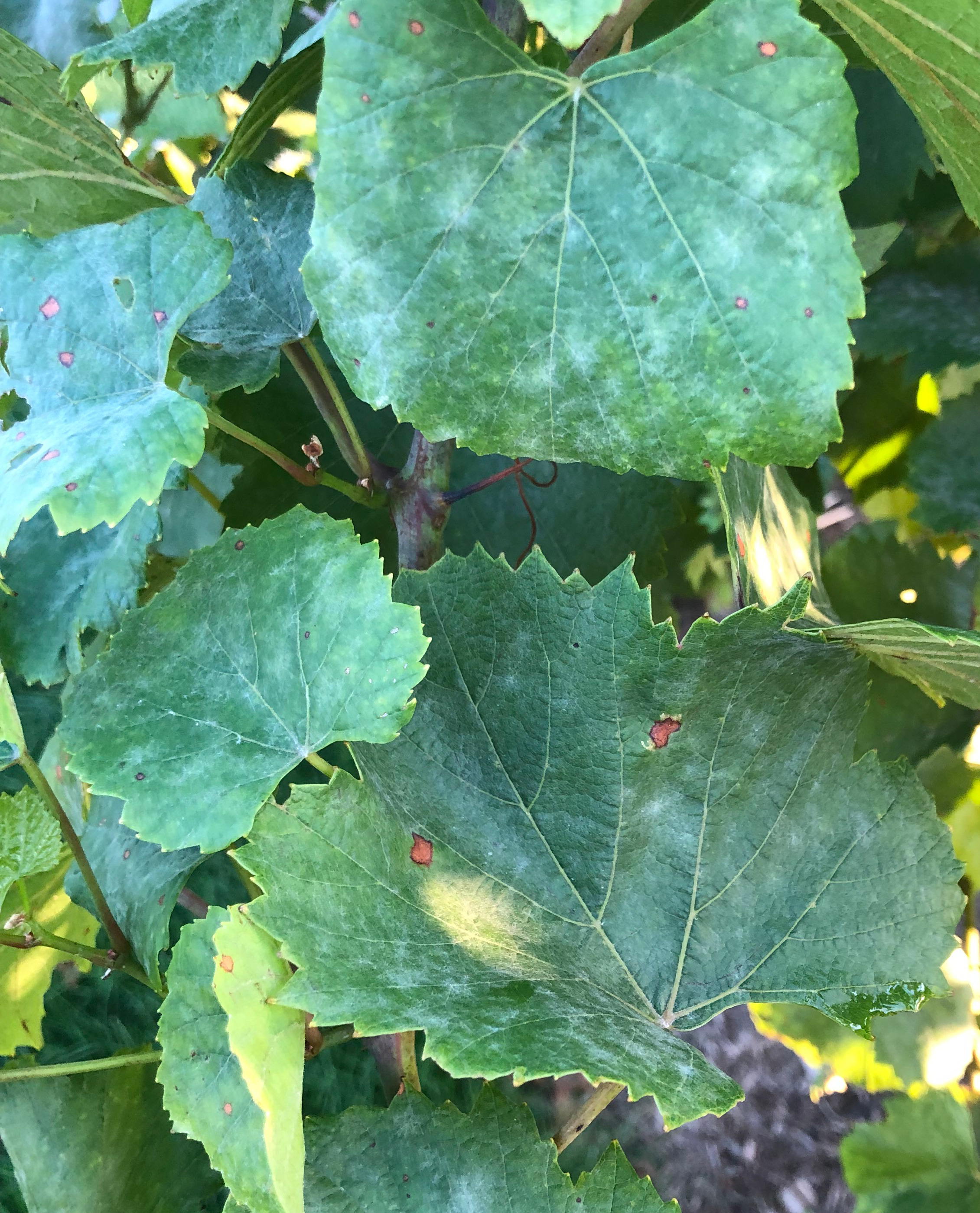Michigan grape scouting report – Aug. 4, 2021
Viticulture Field Day was a success. There are several other events planned for the year.

Weather
Last week started hot and humid in southern Michigan with high temperatures near 90 degrees Fahrenheit. Northern parts of the state were more seasonal. A cold front passed through the state on Thursday, dropping temperatures into the low to mid-70s and bringing a third to an inch of rain to areas near Lake Michigan. The cool temperatures continued through the weekend.
A gradual warm-up started on Tuesday with temperatures close to 80 F that will increase to near 90 F in southern Michigan by the start of next week. Northern grape regions will be 5-10 degrees cooler. There are chances of rain in northern areas on Friday and Saturday. Southern areas are expected to remain dry.
Last week we picked up an average number of growing degree days (GDD),110-140 GDD base 50. The southwest region is 440 GDD base 50 ahead of the northwest region. Statewide, we are only a couple days ahead of the five-year average.
|
Northwest Michigan GDD summary from March 1 – Aug. 2, 2021 | |
|---|---|
|
Northwest stations |
GDD 50 F |
|
Petoskey (Petoskey) |
1327 |
|
Traverse City (NWMHRC) |
1446 |
|
Old Mission (Old Mission) |
1404 |
|
Average for northwest region |
1374 |
|
Average last week |
1265 |
|
Southern stations |
|
|
Benton Harbor (SWMREC) |
1850 |
|
Lawton (Lawton) |
1842 |
|
Fennville (TNRC) |
1649 |
|
Average for southwest region |
1814 |
|
Average last week |
1677 |
|
Romeo (Romeo) |
1747 |
|
Average for southeast region |
1781 |
|
Average last week |
1643 |
Vine growth
In southwest Michigan, veraison has begun. Several red hybrid varieties such as Marquette, Regent and Geneva Red are in different levels of color change. Cabernet sauvignon and Tempranillo are also showing signs of early veraison. Some sites in the southwest part of the state, impacted by the spring freezes, are not expected to be harvested because of the very low crop. In these freeze-damaged sites, a reduced pest and disease program may be warranted. See “Pest management approaches in a winter or freeze damaged grape vineyard” from Michigan State University Extension for recommendations.
In northern vineyards, most varieties are at berry touch to bunch closure, depending on how tight-clustered the variety is. See this chart for grape growth stages.

Horticulture
Hedging is being done in vineyards in northern Michigan now. Hedging's main goal is to remove excess primary and lateral shoot growth from the canopy's top and sides, preventing shading and shoot entanglement between vine rows and allowing worker and tractor traffic through the vineyard. Hedging reduces canopy size by cutting primary and lateral shoots, but it does not directly reduce the vine's inherent vigor. When done in early to midsummer, hedging can further promote growth by inducing lateral shoot growth in vigorous sites.
Hedging is usually performed from fruit set to véraison, when primary and lateral shoots begin to bend above the last set of catching wires (45-degree angle). It is important to keep leaves, fruit and developing buds exposed to light in dense canopies with excessive vegetative growth. Hedging too early in the growing season should be avoided because it can cause lateral growth and canopy density to increase.
Diseases
At this time of year, the main diseases to focus on are downy mildew and powdery mildew. Fungicides that include broad-spectrum/contact fungicides like the EBDCs (FRAC M3) and captan are effective products for resistance management. Viticultural practices that reduce canopy wetness such as good irrigation timing, leaf removal and good weed management can reduce these diseases in a vineyard.
At this time of year, the main concern with downy mildew is late season defoliation. Defoliation will impact winter hardiness and survival, as well as health of the vine next year. Downy mildew is caused by a fungal-like organism, so many site specific systemic fungicides that target other spring diseases do not work on downy mildew. Effective fungicides for downy mildew include products in FRAC codes 4, 11, 21, 40 and 45 as well as phosphorus acid salts and some biologically-based products.
If powdery mildew is the only concern, there are a number of products that are effective (FRAC codes 3, 7, 11, 13, U8, 50, and U13 as well as sulfur).

As we approach bunch closure, it is important to consider botrytis management. Several strategies contribute to good botrytis bunch rot management including opening up the canopy, properly applying fungicides and using resistant cultivars when possible. Good botrytis control depends on getting good coverage. Just before bunch closure is the last chance to apply a fungicide to the inner part of the developing cluster. The most effective products for botrytis are site specific and prone to resistance development. A Michigan Grape Fact Sheet is now available for managing botrytis bunch rot.
Remember, as you choose a fungicide, check the guide for potential phytotoxicity of certain sprays on Concord grapes especially (this has been particularly noted for fungicides like Revus Top). Phytotoxicity risk is higher with high temperatures and quickly growing vines. Also, there is a significant phytotoxicity risk with specific contact products such as copper and sulfur for Labrusca type grapes (Concord and Niagara).
It is important to remember to manage fungicide resistance and avoid applying similar products back-to-back. This is particularly important with site-specific systemic fungicides. To reduce the development of resistance with systemic fungicides:
- Do not make more than two applications per season of the same FRAC code.
- Do not make two consecutive applications of the same FRAC code.
- Rotate with unrelated fungicides in a different FRAC code that have efficacy on the target pathogen.
- Include a contact multisite fungicide into a program (e.g., sulfur, captan, oils or biological fungicides).
This is a good time to scout for suspicious issues related to other vine stressors. Many of these problems can be abiotic including nutrient related issues and graft incompatibility, but some of the biotic problems can be caused by grapevine trunk diseases or grapevine viruses. If you are interested in taking samples and testing, you can send them to MSU Plant & Pest Diagnostics. Please see these articles on grapevine trunk disease and sampling for grapevine viruses.
Insects
The beginning of egglaying from the third generation of grape berry moth should begin this week. Management of this generation is important. This third generation has the potential to have the biggest impact on total harvested tonnage.
Sprays targeting eggs such as Intrepid and Altacor should go out this week. Sprays targeting the emerging larvae should be applied 100 GDD base 47 after the start of egglaying. This is usually four days later this time of year. Calibrate sprayers to target sprays onto clusters, where grape berry moth would be present. Use enough water to ensure canopy is penetrated and clusters are completely covered.
There are a number of broad-spectrum insecticide options that have activity against young larvae such as Altacor, Delegate and Verdepryn. Imidan is also effective against grape berry moth but must be applied in water that is pH 5-5.5 for maximum activity. Multiple pyrethroid insecticides and the carbamate Sevin are also registered and can provide a week of protection, but they can also disrupt biological controls. For more detailed information to help with choosing the right insecticide, see: Mid-season management of grape berry moth.
Upcoming events
Parallel 45 Vines & Wines and Michigan State University Extension will hold a hybrid meeting (in-person and over a Zoom call) on Aug. 6, 2021, from 3-5 p.m. at the Northwest Michigan Horticulture Research Center (NWMHRC), 6686 S Center Hwy Traverse City, MI 49684. Advance registration is not required. See this article for more information: Join us for a northwest Michigan grape pre-veraison meeting Aug. 6, 2021
Longtime Michigan State University Extension small fruit educator, Mark Longstroth, is retiring from extension duties. He is having his retirement party on August 18, 2021, from 4-7pm at Modales Winery, 2128 62nd St, Fennville, MI 49408. All are welcome. Please RSVP. Contact Melissa Franklin at 269-657-8213 or frank126@msu.edu by August 10 to RSVP or any time for more information on the event.
The Michigan Grape Society will be sponsoring one last evening Grower’s Social event before harvest begins. This event will be hosted by Michigan State University Extension at the Southwest Michigan Research and Extension Center on Thursday, Aug. 26, 2021. The event will begin at 6 p.m. with a discussion about season extension and winter protection through the use of high tunnels in grape production. Food and drink will follow. There will be limited attendance. Pre-registration is highly recommended.



 Print
Print Email
Email
